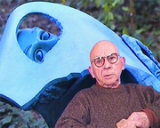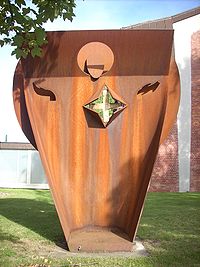
Jean-Robert Ipoustéguy
Encyclopedia

France
The French Republic , The French Republic , The French Republic , (commonly known as France , is a unitary semi-presidential republic in Western Europe with several overseas territories and islands located on other continents and in the Indian, Pacific, and Atlantic oceans. Metropolitan France...
sculptor, was born "Jean Robert" in Dun-sur-Meuse
Dun-sur-Meuse
Dun-sur-Meuse is a commune in the Meuse department in Lorraine in north-eastern France....
.
Studied painting and drawing in Paris in 1938, under Robert Lesbounit.
After World War II, he earned his living creating frescos and stained glass windows for Saint-Jacques, Petit-Montrouge
Petit-Montrouge
The quartier du Petit-Montrouge is number 55 of the 80 quartiers administratifs in Paris. It lies in the 14th Arrondissement, in the south of the capital. It owes its name to the adjacent commune of Montrouge, of which it formed a part before 1860...
.
In the 1950s, at about the same time he turned from oil painting to sculpture and other media, the artist chose to add his mother's maiden name, "Ipoustéguy", to his name, since "Robert" is a common surname
Surname
A surname is a name added to a given name and is part of a personal name. In many cases, a surname is a family name. Many dictionaries define "surname" as a synonym of "family name"...
in France.
In 1979, his largest sculpture, L'homme construit sa ville, was installed at the Congress Centre in Berlin
Berlin
Berlin is the capital city of Germany and is one of the 16 states of Germany. With a population of 3.45 million people, Berlin is Germany's largest city. It is the second most populous city proper and the seventh most populous urban area in the European Union...
.
In 1982 Place Pradel, in Lyon.
In 1985 Arthur Rimbaud, in Paris
In 1989 A la santé de la Révolution, in Bagnolet (France)
In 1991, Nicolas Appert
Nicolas Appert
Nicolas Appert , was the French inventor of airtight food preservation. Appert, known as the "father of canning", was a confectioner.-Biography:...
in Châlons en Champagne (France).
In 1999, Porte du Ciel, Braunschweig.
In 2001 he set up in the church of Dun-sur-Meuse his sculpture Death of Bishop Neumann, produced in 1976. She had been refused by the Americans.
Ipoustéguy is buried at Cimetière de Montparnasse
Montparnasse Cemetery
Montparnasse Cemetery is a cemetery in the Montparnasse quarter of Paris, part of the city's 14th arrondissement.-History:Created from three farms in 1824, the cemetery at Montparnasse was originally known as Le Cimetière du Sud. Cemeteries had been banned from Paris since the closure, owing to...
, Paris
Paris
Paris is the capital and largest city in France, situated on the river Seine, in northern France, at the heart of the Île-de-France region...
.
Prizes, Awards and Honors
- 1964, Bright Prize, Venice BiennaleVenice BiennaleThe Venice Biennale is a major contemporary art exhibition that takes place once every two years in Venice, Italy. The Venice Film Festival is part of it. So too is the Venice Biennale of Architecture, which is held in even years...
exhibition - 1977, Grand National Prize for Art
- 1984, chevalier de la Légion d'honneur
- 2003, Prix de la sculpture de la Fondation Simone et Cino Del Duca.

Museum
Abu Dhabi, National Museum of Saadiyat Island.Baltimore, Baltimore Museum of Art.
Berlin, Nationalgalerie.
Bobigny, Fonds Départemental d’Art Contemporain.
Châlons en Champagne, Musée des Beaux-Arts et d'Archéologie.
Chicago, Art Institute.
Copenhagen, Carlsberg Glyptotek.
Darmstadt, Hessiches Landesmuseum.
Dun sur Meuse, Centre Ipoustéguy
Grenoble, Musée d’Art Moderne.
Hannover, Sprengel Museum.
London, Tate Gallery.
London, Victoria and Albert Museum.
Lyon, Musée des Beaux-Arts.
Marseille, Musée Cantini.
Melbourne, National Gallery of Victoria.
New York, The Museum of Modern Art.
New York, Solomon R. Guggenheim Museum of Art.
Paris, Musée d’Art Moderne de la Ville de Paris.
Paris, Musée de la Sculpture en Plein Air.
Pittsburgh, The Carnegie Museum.
Tokyo, Hakone Museum of Art.
Toulouse, Artothèque.
Troyes, Musée d’Art Moderne.
Washington, Hirshhorn Museum and Sculpture Garden.

